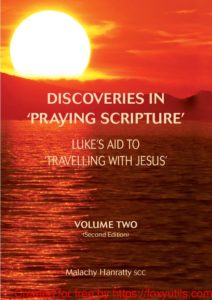 Discoveries in Prayer Vol I & II
Discoveries in Prayer Vol I & II
“But where does love come from?” a musing person might exclaim as in this needy, self-centred, contending world he or she sees many examples of self-sacrificing generosity and commitment.
The following idea might help. The Creator puts in everyone’s heart two seeds: the first a yearning to be loved; the second yearning to love! Fulfilment developing in the first relentlessly urges growth in the second. Growth in both requires quiet time or openness to noticing the heart being moved and gradually changed.
This increases from thankfulness for helps-in-need to becoming aware of gifts in co-incidents, in reconciliations, in beauty, in music, in oneself being surprisingly generous, patient, trusting, even to forgiving another person: – all gifts!
 Who gives them? These two booklets, Discoveries in Prayer Vol I and II, deal with discoveries of helps as one travels on this inner journey of the heart. It draws the heart into uniting more with the ‘Gift-Giver’ and thus with others.
Who gives them? These two booklets, Discoveries in Prayer Vol I and II, deal with discoveries of helps as one travels on this inner journey of the heart. It draws the heart into uniting more with the ‘Gift-Giver’ and thus with others.
As missioners in Japan, a highly developed, 98% non-Christian, First World Asian country, deeply absorbed in overcoming the ravages of war we were so frustrated. But emanating from the Second Vatican Council we were greatly thankful for many insights and understandings. Among our changed ways of doing things I began classes with a few Seekers, Catechumens and new Christians.
This booklet is the fruit of what I experienced in over fifteen years of guiding so many groups before they began the classes for ‘Introducing Christ’.
 Praying Scripture Vols I & II – Luke’s Aid to ’Travelling with Jesus
Praying Scripture Vols I & II – Luke’s Aid to ’Travelling with Jesus
Our next step would be meeting Jesus. This is the Revelation that the loving Creator had sent His Son, Jesus into this world to save us from our ‘fallen away’ condition due to our ignoring that ‘what had we that we had not received?’ and wanting self-sufficiency, independence and control.
‘Emptying himself to be like us, living in lowly conditions, he went around doing good’, showing love, patience, healing, forgiveness, drawing followers.
 Praying Scripture is the help that a text of Scripture gives towards a personal ‘conversation’ with God. We are realising that what we see God doing in the Scripture in the past is telling us what He is doing here and now among us.
Praying Scripture is the help that a text of Scripture gives towards a personal ‘conversation’ with God. We are realising that what we see God doing in the Scripture in the past is telling us what He is doing here and now among us.
It entails not just talking to God about how it touches one’s heart but more importantly it means waiting attentively to seeing things and feeling things in the heart in a new way.
It might recall experiences or emotions or use the imagination but all these movements give messages from God. Vatican II encouraged this practice among ordinary Christians. Group sharing about discoveries is an extra benefit.
 Resurrection Gifts
Resurrection Gifts
Another ‘praying’ Scripture booklet. The Resurrection of Jesus Christ is the central part of God’s revelation. It leads us in our prayer and sacraments to experience meeting the loving heart of the Saving God. This leads to a deepening relation with, not only the Blessed Trinity, but with all God’s ‘children’. And the first herald of this ‘Good News’ is the heart-shattered yet faithful Mary of Magdala.
The Emmaus event, in our prayer, increases out awareness of God listening to us and drawing us to listen to Him. Such prayer changes our minds, heart and trust leading into thanksgiving and sharing. It points to our Eucharist, so life-giving, deepening our relationship with the Risen Lord and with others. I notice the earliest apparitions are to followers but not Apostles. The apparition to the eleven apostles astounds them but I am surprised at ‘forgiveness’ being so centrally emphasised here so early.
Then I notice the Holy Spirit is being emphasised. This tells us how necessary the Spirit is for our Christian growth. Thomas shows how our increased awareness of being forgiven deepens the relationship to God.
Next we are reminded that the drawer of others into the fold and the carer must show a heart like Jesus. But we can only spread Christianity by our growing awareness that God loves us first! It takes listening prayer time to deepen this. It contains the desire to spread this and that is really only done by example.
They come back from the Ascension with joy, not sad at parting but rejoicing now feeling Jesus is with the Father and with them by their Spirit. They are more deeply praying preparing for the fuller reception of the influence of the Spirit. Mary, who gave herself in complete trust to the Spirit and with the motherly heart as Jesus’ mother, spends much time with them. She prays that the disciples and all followers respond to the gift of being loved and led by the Spirit in TRUST. It will help them accept ‘crosses’ in their everyday life as she did and follow in dependence on and Trust in God’s omnipotence and love. This prepares them – and us – for Pentecost.
 Luke Helping Us to Listen in Prayer
Luke Helping Us to Listen in Prayer
Brief Explanation of ‘Praying Scripture’
(Hints for personal prayer, Adoration, prayer groups, private or small retreats, group reflections)
Introduction
The Church’s Vatican II General Council’s object was to rejuvenate the Pilgrim Church on its journeying through the modern world. It re-emphasised the fundamental truths that ‘God Loves us First’, that each one is called into a deepening, conscious relationship with Jesus Christ, and into responding to the guidance of God’s Spirit. This leads us all into Unity.
Emphasising that what we see God doing in Scripture makes us more aware of what He is doing, here and now, among us. So, the council encouraged that the practice of prayerful ‘listening’ to the Spirit in the Scriptures (Lectio Divina) be developed! It made me aware that I had spent time talking to God. But this ‘pondering’ the Word of God’ changed my prayer towards more of an ‘interaction’; it provided space, patience and openness to ‘listen’, to be moved inwardly. So ‘Praying Scripture’ is the help that a text of Scripture gives towards this personal conversation with God.
Remember, that what we see God doing in the Scriptures in the past, is telling us what He is doing, here and now among us! So, beyond our talking to God, this helps us to ‘listen’. We ‘listen’ by noticing movements in the heart and mind. Examples: A word in the text may hold my attention and as I dwell on it I notice things in a new way or, pulled by imagination deeper into the scene. It can cause memories of experiences to arise.
Gradually you will find different and deeper insights from yourself or from others but hopefully these examples of mine help you to begin a fruitful ‘praying Scripture’. I recommend first reading the whole planned text. Then gazing attentively at it, allow the Spirit to lead you here and there. In your planned length of pondering time you may be held on a certain word or part of the text. Stay here as long as held.
Then, when you feel drawn, continue the text till stopped again. Even after times of having used the whole text one can feel drawn back to it again and again – each time it can provide further noticing. These ‘Guided Meditations’ are examples of my pondering. Find what moves you!
